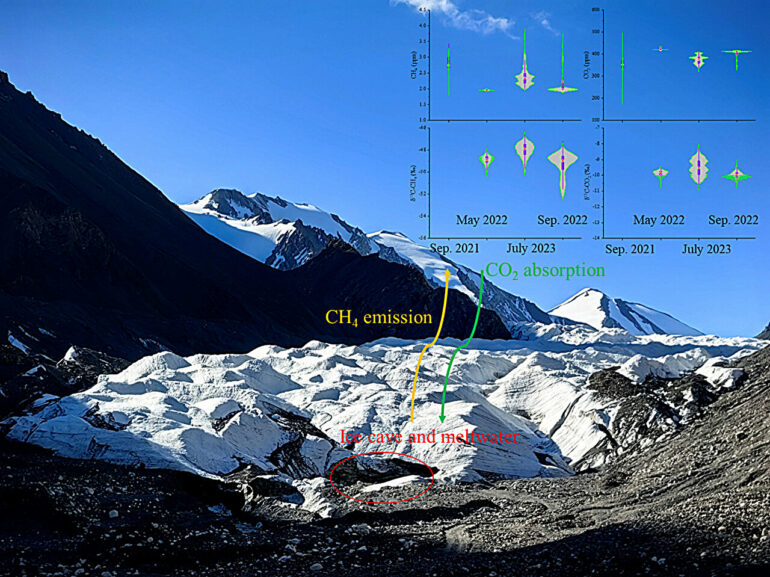The retreat of high mountain glaciers has accelerated since the 1980s, resulting in increased glacier runoff. However, it remains uncertain whether melting mountain glaciers enhance or release greenhouse gases, and whether areas exposed to glacier retreat emit or absorb such gases.
Therefore, understanding the impact of glacier meltwater on downstream recharge areas in aquatic systems is critical for high mountain glaciers.
A research team led by Du Zhiheng from the Northwest Institute of Eco-Environment and Resources of the Chinese Academy of Sciences, together with collaborators from Beijing Normal University and Lanzhou University, monitored changes in methane and carbon dioxide concentration and their isotope data in ice caves on a high-mountain glacier in China from 2021 to 2023.
The research is published in the journal Science of The Total Environment.
The researchers examined methane emission and carbon dioxide absorption in ice caves and meltwater of Laohugou No.12 Glacier, which is the largest continental glacier in the Qilian Mountains. They conducted four field campaigns and found increased methane levels (up to 5.7 ppm) and decreased carbon dioxide levels (down to 168 ppm) in the ice cave.
Furthermore, significantly higher methane concentrations were observed during the strong ablation season (July 13-16, 2023). Although these levels are relatively low compared to data from Greenland glaciers, the results highlight the potential impact of methane and carbon dioxide on future glacier carbon budgets.
The in-situ carbon isotope data (δ13C-CH4 and δ13C-CO2) suggest that methane production is mainly due to acetoclastic methanogenesis, but the thermogenic methane production mechanism cannot be excluded. Furthermore, methane emissions seem to be influenced by meteorological factors such as wind speed, wind direction and meltwater runoff
The seasonal data indicate different flux patterns of methane and carbon dioxide between the glacial outlet cavity and the subglacial environment, resulting in their release to the atmosphere and accelerating glacier melting. Recent data show that 17.2% (5,956 out of 34,578) of small glaciers with a total area of 1,127.2 km2 have disappeared in China over the past half century.
These results demonstrate that as high mountain glaciers melt, more ice caves or subglacial channels are formed within drainage systems, releasing significant amounts of methane along with large pools of carbon substrate into the atmosphere.
More information:
Zhiheng Du et al, Characteristics of methane and carbon dioxide in ice caves at a high-mountain glacier of China, Science of The Total Environment (2024). DOI: 10.1016/j.scitotenv.2024.174074
Provided by
Chinese Academy of Sciences
Citation:
Melting high-mountain glaciers would release greenhouse gases into atmosphere, suggest scientists (2024, July 12)



